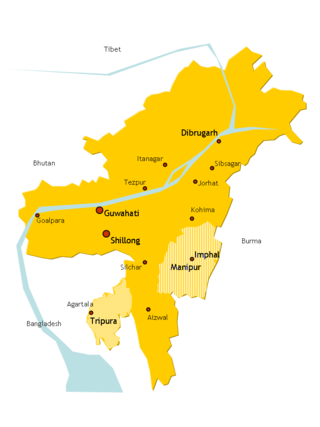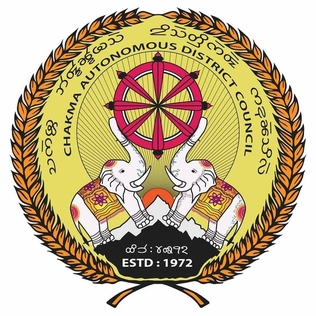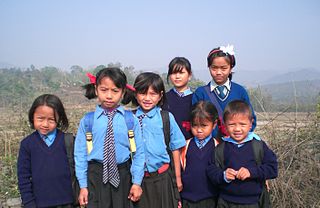
Mizoram is a state in northeast India, with Aizawl as its seat of government and capital city. The name of the state is derived from "Mizo", the endonym of the native inhabitants, and "Ram", which in the Mizo language means "land." Thus "Mizo-ram" means "land of the Mizos". Within India's northeast region, it is the southernmost landlocked state, sharing borders with three of the Seven Sister States, namely Tripura, Assam and Manipur. The state also shares a 722-kilometre (449 mi) border with the neighbouring countries of Bangladesh and Myanmar.
Hmar is a Kuki ethnic group living in Northeast Indian state of Manipur, Mizoram, Assam and western Myanmar (Burma) and eastern Bangladesh. They use Meitei language as their second language (L2) in Manipur. They speak Mizo language as their L1 in Mizoram.
Mizo Union was the first political party in Mizoram, northeast India. It was founded on 6 April 1946 at Aizawl as the Mizo Common People's Union. At the time of independence of India from the british rule in india in 1947, the party was the only political force in the Lushai Hills. It won the first Mizoram District Council general election under the new Indian Union in 1951, and consecutively in 1957, 1962 and 1966.
The Mizo National Front is a regional political party in Mizoram, India. MNF emerged from the Mizo National Famine Front, which was formed by Pu Laldenga to protest against the inaction of the Government of India towards the famine situation in the Mizo areas of the Assam state in 1959. It staged a major uprising in 1966, followed by years of underground activities. In 1986, it signed the Mizoram Accord with the Government of India, renouncing secession and violence. The MNF then began contesting elections and has formed state government in Mizoram three times. It is currently the state's ruling party, with its president, Zoramthanga, as the Former Chief Minister of Mizoram.

The Insurgency in Northeast India involves multiple separatist militant groups operating in some of India's northeastern states, which are connected to the rest of India by the Siliguri Corridor, a strip of land as narrow as 14.29 miles (23.00 km) wide.

The Mizo people, historically recorded as the Lushais, are an ethnic group native to the state of Mizoram in India and neighbouring states of Northeast India. They speak the Tibeto-Burman language of Mizo, the official language and lingua franca of Mizoram. The state is the second most literate state in India, at more than a rate 90%.

The history of Mizoram encompasses the history of Mizoram which lies in the southernmost part of northeast India. It is a conglomerate history of several ethnic groups of Chin people who migrated from Chin State of Burma. But information of their patterns of westward migration are based on oral history and archaeological inferences, hence nothing definite can be said. The recorded history started relatively recently around the mid-19th century when the adjoining regions were occupied by the British monarchy. Following religious, political and cultural revolutions in the mid-20th century majority of the people agglomerated into a super tribe, Mizo. Hence the officially recognised settlement of the Mizos became Mizoram.
Laldenga was a Mizo separatist and politician from Mizoram in northeast India. He was the founder of the Mizo National Front, a social organisation turned political party. He was the first Chief Minister of Mizoram as a federated state, the office of which he held from 1986 to 1988.

The Chakma Autonomous District Council (CADC) is an autonomous council for the Chakma people living in the south-western part of Mizoram, India. It covers the Tuichawng (Chawngte) subdivision of Lawngtlai district. Its headquarters is at Kamalanagar. The Chakma people has been demanding to change the status of the Chakma Autonomous District Council into a Union territory under the name Chakmaland.
Brigadier Ṭhenphunga Sailo, AVSM was an officer of the Indian Army, and the second and twice the Chief Minister of Mizoram, a state in northeast India. He was the creator of Mizoram People's Conference, one of the major political parties in Mizoram. He was a recipient of Ati Vishisht Seva Medal (AVSM) and Padma Shri for his humanitarian works during his military service, and Mizo Award for his lifetime achievements.
Naga nationalism is an ideology that supports the self-determination of the Naga people in India and Myanmar, and the furtherance of Naga culture.

The Mizo National Front uprising was a revolt against the government of India aimed at establishing a sovereign nation state for the Mizo people, which started on 28 February 1966. On 1 March 1966, the Mizo National Front (MNF) made a declaration of independence, after launching coordinated attacks on the Government offices and security forces post in different parts of the Mizo district in Assam. The government retaliated and recaptured all the places seized by the MNF by 25 March 1966.
Secession in India typically refers to state secession, which is the withdrawal of one or more states from the Republic of India. Whereas, some have wanted a separate state, union territory or an autonomous administrative division within India. Many separatist movements exist with thousands of members, however, some have low local support and high voter participation in democratic elections. However, at the same time, demanding separate statehood within under the administration of Indian union from an existing state can lead to criminal charges under secession law in India. India is described as an ‘Union of States’ in Article 1 of the Indian constitution I.e "Indestructible nation of destructible states" by its father of constitution Dr. Bhimrao Ramji Ambedkar where a state or Union territory of India can't secede from India by any means and the Central Government have more powers then the respective state governments and can forcefully change the name, boundaries of the states without their permission at any time when needed for self interest and for the maintenance of integrity.

Christianity is the largest religion in Mizoram. The majority 87% of Mizoram population are Christian in various denominations, predominantly Presbyterian. More than 98% of the Mizos are Christians by faith. The Government of Mizoram declared that Christianity plays a very important role among the daily life of Mizo community and therefore further declared that Christianity as the religion of the state. The culture of Mizoram is mainly influenced by Christianity. Hence, Christianity was given a special status on the state by the government while maintaining a minimum level of secular environment and approach. In June 2018, the government of Mizoram including Vanlalruata, president of anti-corruption organisation-turned-political party, People's Representation for Identity and Status of Mizoram claim that Mizoram is a Christian state. Hindus form a small minority (3.55%) mainly of Manipuris and there are also around (7.93%) Buddhists according to the 2001 census, mostly made up from Chakma settlers of Arakan origin. There are about 8,000 mostly ethnic Mizo followers of a Judaic group Bnei Menashe, who claim descent from the biblical Menasseh. Muslims make up about 1.1% of the state population.
The Mizoram Peace Accord, 1986 was an official agreement between the Government of India and the Mizo National Front (MNF) to end insurgency and violence in Mizoram, India, that started in 1966. The Mizo National Front was an organisation of Mizo secessionists led by Laldenga to fight for independence from India. The movement was basically due to lack of support from the government during the great famine in Mizoram in the late 1950s. Political insurgency and social unrest ensued in the next decades. After a number of negotiations, the document titled Mizoram Accord, 1986: Memorandum of Settlement was finally signed on 30 June 1986. It was signed by Laldenga for MNF, R.D. Pradhan, Home Secretary, Government of India, and Lalkhama, Chief Secretary, Government of Mizoram. It is remarked as the most and only successful peace agreement in India after its independence from British Empire in 1947.

The hill tribes of Northeast India are hill people, mostly classified as Scheduled Tribes (STs), who live in the Northeast India region. This region has the largest proportion of scheduled tribes in the country.
Elections to the Mizoram Legislative Assembly were held in May 1978 to elect members of the 30 constituencies in Mizoram, India. The Mizoram People's Conference emerged as the single largest party and T. Sailo was appointed as the Chief Minister of Mizoram.

British rule in the Lushai Hills, spanning from the late 1889 to the 1947, commenced with the Chin-Lushai Expedition of 1889-90 leading to the formal establishment of the two administrative districts in 1889 and continued through the integration of the regions into the province of Assam with both districts being merged as the Lushai Hills until India gained independence in 1947.

The Mizo District, also known as the Lushai Hills District, was an autonomous district council of the Indian state of Assam from 1947 till 1972 until it was granted the status of a Union Territory. This region was a significant part of Mizo history as it formally abolished the Mizo chieftainship system in 1952.










